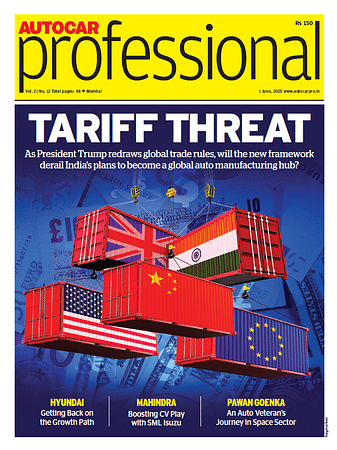China's Rare Earth Export Restrictions Threaten India's Automotive Production: CRISIL
Supply-chain disruption may impact production and growth trajectory of the automotive sector.
India's automotive sector faces potential production disruptions and delayed electric vehicle launches due to China's export restrictions on rare earth magnets, which India imports over 80 percent of its requirements from the dominant global supplier. The restrictions, implemented in April 2025, mandate export licenses and detailed end-use disclosures, creating a clearance process that takes at least 45 days and has resulted in no approved shipments to India by end-May 2025.
China imposed export restrictions on seven rare earth elements and finished magnets in April 2025, requiring exporters to obtain licenses and provide detailed end-use disclosures and client declarations. The framework specifically prohibits products intended for defense applications or re-export to the United States. The enhanced scrutiny has created significant delays in the approval process, with a growing backlog further slowing clearances and tightening global supply chains.
India sourced over 80 percent of its approximately 540 tonnes of magnet imports from China in the previous fiscal year. By end-May 2025, nearly 30 import requests from Indian companies had received endorsement from the Indian government, but Chinese authorities had not approved any requests, resulting in no shipments arriving in India.
The supply disruption affects the production of permanent magnet synchronous motors used in electric vehicles for their high torque, energy efficiency and compact design. Hybrid vehicles also depend on these magnets for efficient propulsion systems. In internal combustion engine vehicles, rare earth magnets are primarily used in electric power steering and other motorized systems.
Says Anuj Sethi, Senior Director, Crisil Ratings, "The supply squeeze comes just as the auto sector is preparing for aggressive EV rollouts. Over a dozen new electric models are planned for launch, most built on PMSM platforms. While most automakers currently have 4-6 weeks of inventory, prolonged delays could start affecting vehicle production, with EV models facing deferrals or rescheduling from July 2025. A broader impact on two-wheelers (2W) and ICE PVs may follow if the supply bottlenecks persist for an extended period."
The automotive sector projects domestic passenger vehicle volumes to grow 2-4 percent in fiscal 2026, while electric passenger vehicles could increase 35-40 percent from a low base. Electric two-wheelers are expected to grow approximately 27 percent, outpacing overall two-wheeler growth of 8-10 percent. However, sustained supply constraints could reduce this growth momentum, particularly in the electric vehicle segment.
The current shortage contrasts with the pandemic period, when rare earth magnet supplies remained stable unlike semiconductors, leading companies to maintain just-in-time inventory practices without building strategic reserves. The rare earth magnet supply chain differs significantly from semiconductors, with over 90 percent of processing concentrated in China compared to the globally diversified semiconductor supply base.
Says Poonam Upadhyay, Director, Crisil Ratings, "The shortage of rare earth magnets is forcing automakers to reassess supply-chain strategies. Despite contributing less than 5% of a vehicle's cost, these magnets are indispensable for EV motors and electric steering systems. Automakers are actively engaging with alternative suppliers in countries such as Vietnam, Indonesia, Japan, Australia, and the US, while also optimising existing inventories. With applications across EVs and ICE vehicles, a prolonged supply squeeze could disrupt production of PVs and 2Ws, making this low-cost component a potential high-impact bottleneck for the sector. In a constrained supply scenario, magnets may also get diverted to ICE models, which require fewer units, potentially impacting EV growth."
The government and automotive manufacturers are implementing responses across two timeframes. Short-term measures focus on building strategic inventories, engaging alternative suppliers and accelerating domestic assembly under Production Linked Incentive schemes. Long-term strategies aim to reduce import dependency through expedited rare earth exploration, development of local production capacity and investment in recycling infrastructure.
Industry stakeholders continue exploring supply source diversification in alignment with policy initiatives. The pace of China's export approval process for rare earth magnets remains the primary factor determining supply availability for India's automotive sector.
RELATED ARTICLES
Need to View Lightweighting from ‘What’ to ‘How’: Anand Kulkarni of Tata Motors
Why Tata Motors’ Anand Kulkarni believes the future of lightweighting lies not in exotic materials, but in scalable, sma...
NBC Bearing’s Light-weighting Strategy Combines Materials, Sensors and Smart Design
The company is starting to use non-metallic, polyamide or specialty plastic cages that can significantly reduce the weig...
Beyond the Gram: The Economic and Environmental Payoff of Material-Optimal Design
Simulation pioneer leverages decades of expertise and generative AI to slash vehicle weight, accelerate development, and...





 By Shruti Shiraguppi
By Shruti Shiraguppi
 11 Jun 2025
11 Jun 2025
 1599 Views
1599 Views





 Ketan Thakkar
Ketan Thakkar


 Yukta Mudgal
Yukta Mudgal

 Shahkar Abidi
Shahkar Abidi

